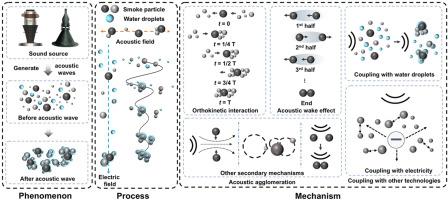火灾烟气控制的声学聚块:最新进展
IF 4.3
2区 材料科学
Q2 ENGINEERING, CHEMICAL
引用次数: 0
摘要
城市建筑日益复杂,火灾风险显著增加,对公共安全构成严重威胁。一旦发生火灾,烟雾颗粒会散射并吸收光线,大大降低能见度,并极大地危及被困人员。现有的烟雾控制方法面临着明显的局限性。自然通风易受环境条件的影响。诸如防火墙之类的固体障碍物会妨碍疏散。细水雾可能悬浮在空气中,降低能见度。此外,这些方法不能直接控制烟雾颗粒,因此需要创新的解决方案。声团聚是利用高强度声场诱导烟雾颗粒之间的相对运动并促进快速团聚的一种有前途的技术,可以提高烟雾弥漫环境中的能见度。它的运行不受环境条件的影响,不需要固体屏障,也不引入额外的颗粒,这凸显了它在疏散和救援方面的优势。本文综述了火灾烟气控制声学聚集的发展、机制、运行参数、声源和混合策略,确定了剩余的差距,并评估了可行性。这些见解旨在支持研究人员和决策者推进更有效的烟雾控制策略。本文章由计算机程序翻译,如有差异,请以英文原文为准。

Acoustic agglomeration for fire smoke control: A state-of-the-art review
The increasing complexity of urban buildings has significantly heightened fire risks, posing serious threats to public safety. In the event of a fire, smoke particles scatter and absorb light, drastically reducing visibility and greatly endangering trapped individuals. Existing smoke control methods face notable limitations. Natural ventilation is susceptible to environmental conditions. Solid obstructions such as firewalls can impede evacuation. Fine water mist may remain suspended in air and reduce visibility. Moreover, these approaches do not directly control smoke particles, so there is a need for innovative solutions. Acoustic agglomeration, which leverages high-intensity acoustic fields to induce relative motion among smoke particles and facilitate rapid agglomeration, is a promising technology for improving visibility in smoke-filled environments. It operates independently of ambient conditions, does not require solid barriers, and introduces no additional particles, which underscores its advantages for evacuation and rescue. This review synthesizes the development, mechanisms, operating parameters, sound sources, and hybrid strategies of acoustic agglomeration for fire smoke control, identifies remaining gaps, and assesses feasibility. The insights are intended to support researchers and decision-makers in advancing more effective smoke control strategies.
求助全文
通过发布文献求助,成功后即可免费获取论文全文。
去求助
来源期刊

Particuology
工程技术-材料科学:综合
CiteScore
6.70
自引率
2.90%
发文量
1730
审稿时长
32 days
期刊介绍:
The word ‘particuology’ was coined to parallel the discipline for the science and technology of particles.
Particuology is an interdisciplinary journal that publishes frontier research articles and critical reviews on the discovery, formulation and engineering of particulate materials, processes and systems. It especially welcomes contributions utilising advanced theoretical, modelling and measurement methods to enable the discovery and creation of new particulate materials, and the manufacturing of functional particulate-based products, such as sensors.
Papers are handled by Thematic Editors who oversee contributions from specific subject fields. These fields are classified into: Particle Synthesis and Modification; Particle Characterization and Measurement; Granular Systems and Bulk Solids Technology; Fluidization and Particle-Fluid Systems; Aerosols; and Applications of Particle Technology.
Key topics concerning the creation and processing of particulates include:
-Modelling and simulation of particle formation, collective behaviour of particles and systems for particle production over a broad spectrum of length scales
-Mining of experimental data for particle synthesis and surface properties to facilitate the creation of new materials and processes
-Particle design and preparation including controlled response and sensing functionalities in formation, delivery systems and biological systems, etc.
-Experimental and computational methods for visualization and analysis of particulate system.
These topics are broadly relevant to the production of materials, pharmaceuticals and food, and to the conversion of energy resources to fuels and protection of the environment.
 求助内容:
求助内容: 应助结果提醒方式:
应助结果提醒方式:


